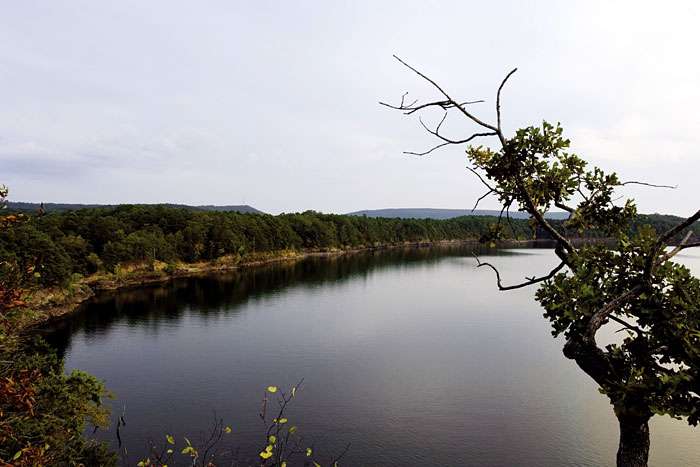
Presented by the Arkansas Department of Parks and Tourism
Anglers from across the country tow their boats to Arkansas to sample the Natural State’s storied fishing for largemouth, smallmouth and spotted bass. If you have an Arkansas bass vacation in mind, consider adding the state’s excellent striped bass and white bass fishing to your list to complete the Arkansas bass slam.
Which of Arkansas’ excellent fishing lakes provide your best shot at the five bass species in the slam? Bassmaster Elite Series pros who call Arkansas home are happy to advise you on where to go and how to catch them. These anglers include Stephen Browning, Mark Davis, Billy McCaghren, Mike McClelland and Scott Rook.
LARGEMOUTH BASS, LAKE DARDANELLE
A 90-mile drive northwest of Little Rock on I-40 takes you to Lake Dardanelle, one of Arkansas’ premier largemouth bass destinations. On the way there, you’ll pass Mayflower, hometown of McCaghren, who has been plying Dardanelle’s waters for nearly 20 years.
Dardanelle, an Arkansas River reservoir, covers 40,000 acres and stretches for 50 miles.
“There are a lot of creeks off the main river that are like small lakes,” McCaghren said. “Just north of Spadra, the lake narrows and becomes more like a river.”
The creeks yield good fishing throughout the year. Water willow, an emergent aquatic grass that grows in shallow water, is high on McCaghren’s hit list.
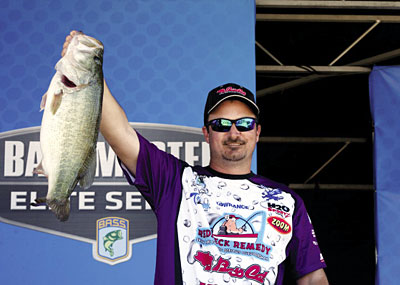 McCaghren fishes the grass with a shallow-running WEC E1 square billed balsa crankbait and a Talon Billy Mac jig .
McCaghren fishes the grass with a shallow-running WEC E1 square billed balsa crankbait and a Talon Billy Mac jig .
“I designed that jig for Dardanelle,” McCaghren said. “It’s good for flippin’ and swimmin’.”
A 3/8-ounce black-and-blue jig dressed with a Zoom Super Chunk does the job when the water is less than 60 degrees. In warmer water, McCaghren switches to a 1/2-ounce jig and a Zoom Speed Craw.
The water willows hold bass throughout the summer and fall, provided the water is high enough. When the water drops too low for bass to stay in the water willows, McCaghren fishes creek channel bends in the backwaters.
A typical creek bend here is 5 to 8 feet deep and drops into 15 feet of water, McCaghren points out. He cranks the drops with a Norman DD22 or a Norman NXS.
“The NXS runs 8 to 9 feet deep on 15- to 20-pound line,” McCaghren said. “You need heavy line because you’ll snag a lot of brushpiles.”
When the bite is slow in the backwaters, McCaghren runs far upriver and fishes wing dams that provide bass with a current break and an ambush point. Key lures are shallow-running plastic square billed crankbaits.
“I paint them black with a Sharpie pen,” McCaghren said. “Keep it simple. Crank the tips of the wing dams and the cuts in front of them.”
SPOTTED BASS, BEAVER LAKE
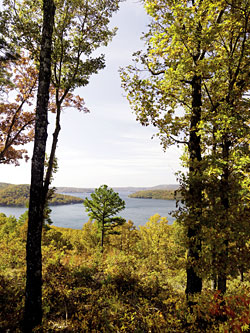
Many Arkansas reservoirs yield excellent fishing for spotted bass. Beaver Lake, situated in the Ozark Mountains of northwest Arkansas, may be the best of them, believes Browning of Hot Springs.
“Beaver Lake might be the clearest reservoir in Arkansas,” Browning said. “It has hundreds of miles of rock and gravel banks, high bluff walls and flooded cedar trees. Spotted bass thrive in that environment.”
The best fishing for spotted bass is from the State 12 bridge near Beaver Shores to the dam. This encompasses the middle and lower sections of the lake.
In springtime, Beaver Lake’s spotted bass spawn in the creek arms and on the main lake. Before and during the spawn, Browning concentrates on chunk rock banks with a 45-degree slope, wherever a creek or river channel swings away from a bank and flooded timber in the 10-foot range.
“A lot of spots spawn against that timber,” Browning said.
His No. 1 bait for Beaver’s spots is a 1/8-ounce shaky head jig dressed with a 5-inch Z-Man Fatty worm. He serves it up with spinning tackle and 6-pound Gamma Fluorocarbon line.
“I get more bites with a light jig and thin line,” Browning said. “If it gets windy, I’ll go as heavy as a 1/4-ounce jig.”
Summertime fishing can be challenging because the spotted bass roam the lake chasing shad, Browning explains.
“The spots at Beaver are notorious for schooling,” Browning said. “They can churn the surface for half an acre.”
The best time to encounter this action is early and late in the day. Make long casts to the frenzy with 3 1/2- to 5-inch walking stickbaits — whatever size matches the size of the shad.
As the lake cools in the fall, Browning recommends that you tie on a 1/2-ounce double-willow War Eagle Screamin’ Eagle spinnerbait with a translucent blue-green skirt and cast it to the windiest banks you can find.
“Burn it back just under the surface with a high-speed baitcasting reel,” Browning said.
SMALLMOUTH BASS, BULL SHOALS
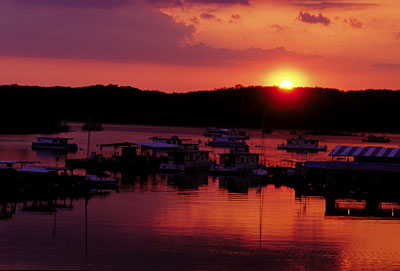
In northern Arkansas lies another scenic mountain reservoir, Bull Shoals Lake. Stretching for 80 miles, this 45,000-acre White River reservoir has a sprawling, undeveloped 700-mile shoreline that is protected by a buffer zone.
McClelland of Bella Vista has enjoyed the views and the fabulous smallmouth bass fishing here for roughly 30 years.
“Anytime I fish Bull Shoals, I know I have a chance at catching a huge smallmouth,” McClelland said. “The state record smallie was caught here. It weighed 7 pounds, 4 ounces.”
Many anglers fail to catch smallmouth bass at Bull Shoals in springtime because they fish too deep, McClelland believes. He looks for sloping banks that have a mix of gravel- to fist-size rock. The most productive places are typically on the main lake or just inside the creek arms and pockets.
“The smallmouth really get aggressive in March and April,” McClelland said. “The best way to catch them then is with a jerkbait.”
McClelland favors the McStick 110 jerkbait that he designed for Spro. He casts it with baitcasting tackle and 10- to 14-pound Sunline Fluorocarbon. You can’t miss with the ghost Table Rock shad and Table Rock shad colors, McClelland claims.
“Smallmouth bass are nomadic, so you have to cover a lot of water,” McClelland said.
Another bait McClelland recommends for springtime smallmouth is a Zoom Fat Albert single-tail grub on a 1/4- or 3/8-ounce jighead. He swims this combination slowly 1 to 2 feet over the bottom.
After spawning, the smallmouth stay in the same general areas but move deeper. McClelland calls them up with poppers and walking stickbaits. When the bass won’t rise to the surface, he gets down to them with a football jig and a 6-inch Zoom Lizard on a Carolina rig. These tactics typically pay off in May and June.
The smallmouth seem to vanish in July and August, but they come back for a return engagement in autumn. Football jigs and grubs coax bites then.
STRIPED BASS, LAKE OUACHITA
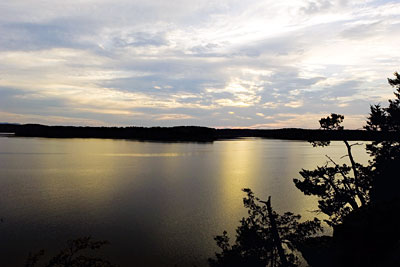
Lake Ouachita, just northeast of Hot Springs, offers superb fishing for heavyweight striped bass. Before Mt. Ida’s Davis became a professional bass angler, he often tangled with stripers while guiding at Ouachita.
“I didn’t really guide for stripers, but we sure caught a lot of them while we were fishing for black bass,” Davis said.
Stripers up to 30 pounds are commonplace at Ouachita, with an occasional 40-pound-class fish coming to the net. The fishermen who specifically target stripers at Ouachita typically troll crankbaits or free spool live shad 10 to 15 feet beneath balloons.
“That’s all good,” Davis said, “but I’d rather catch them on top. Ouachita has world-class topwater fishing for stripers.”
May and June are prime months for this explosive opportunity, Davis points out. He suggests that you concentrate on the upper third of the lake. Key locations are the many main-lake flats you’ll find in this portion.
“Keep your boat over 25 to 30 feet of water and cast into 5 to 15 feet over the flat,” Davis said. “Then walk a Strike King KVD Sexy Dawg or rub a big 10-inch Red Fin on the surface.”
A light action 7 1/2-foot flippin’ stick with 20-pound monofilament line subdues Ouachita’s hard-battling stripers for Davis. Then again, he landed his biggest striper, a 42-pounder, on a 6 1/2-foot bass rod and 15-pound line.
“Sometimes they’ll swirl on your topwater bait several times before they finally smash it 20 feet from the boat,” Davis said. “I compare it to fishing for peacock bass in South America.”
When the stripers migrate to the lower end of Lake Ouachita in the summer, they relate to long points and humps 40 to 45 feet deep. This is when Davis breaks out a 3/4- or 1-ounce Hopkins Shorty spoon and Strike King’s Sexy flutter-structure spoon.
“I’ll drop a spoon straight down to stripers I see on my graph and hop it in their faces,” Davis said.
WHITE BASS, LAKE MAUMELLE
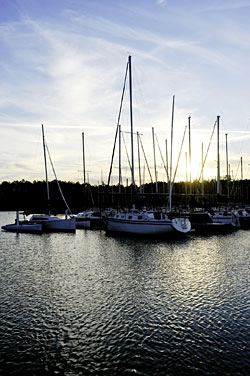
Lake Maumelle is a short cast west of Little Rock, which is home to Rook. As a young teen, Rook cut his teeth crappie fishing at this 8,900-acre reservoir.
“Maumelle is where I started tournament fishing for bass, too,” Rook said.
Rook has also tangled with Maumelle’s plentiful white bass. This aggressive fish is a hard-fighting eating machine. Hook into a 2- to 3-pounder at Maumelle, and you’ll think you’re dealing with a critter twice that size. If you can get within a cast of a school of white bass, you’d better be ready to rumble. They’re not picky.
“The white bass move to the west end of the lake in the spring and run up the main tributary to spawn,” Rook said. “You have to go up beyond a bridge to get to them.”
The fish gang up on dropoffs and points in 2 to 3 feet of water, where they are susceptible to any lure that resembles a shad. An 1/8-ounce jig dressed with a 3-inch curled-tail grub or Sassy Shad is killer. Small spinners and jerkbaits also work well.
“That’s when you can sit in one spot and catch 100 white bass in a day,” Rook said.
After spawning, the white bass migrate back to the main lake, where they constantly roam in search of shad. They stay in this mode from May through September, Rook claims.
“When the shad go to the bank, the white bass are right there with them,” Rook said. “When the shad are out in the middle of the lake, that’s where you’ll catch the white bass.”
The best way to find nomadic white bass is to look for breaking fish. A group of boats can also tip you off to a feeding spree. A 1/2- or 3/4-ounce jigging spoon keeps Rook in touch with Maumelle’s white bass in the summertime.
“You can cast a jigging spoon a long way,” Rook said. “I rip it through schooling fish and let it flutter down through them. There are always fish sitting under the melee that are ready to bite.”





